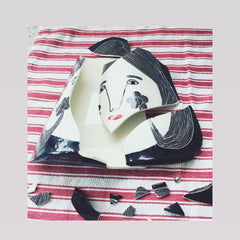Conversations w/ Good People: Nobuko Okamoto
The word ‘Kintsugi’ has quite a simple, literal meaning. Kin means gold and tsugi means to join or fix. Christchurch creative Nobuko Okamoto has been practising Kintsugi for over seven years and still considers herself a novice in the art. Alongside her studies and work, she’s been fixing ceramic pieces for clients here in New Zealand for about a year now. We visit her in her home studio to chat about the slow and delicate process of Kintsugi and what she loves most about it.

Tell us a little about what drew you to the art of Kintsugi and how you got started.
I always knew a little about Kintsugi because I liked ceramics and had a lot of collections in Japan. After the earthquake I had a few broken things and that’s when I first picked up a book about Kintsugi. I wanted to learn and randomly visited a Kintsugi artist to ask him to teach me. At first he refused and said he’s an artist and craftsman not a teacher, but I kept persisting and he eventually gave in. I visited him once a week for seven years, learning and assisting him.
I didn't think I would be able to do it on my own overseas as most Kintsugi artists are from an older generation and have been doing it for over 50 years. I asked my teacher for advice and he encouraged me to go for it. He taught me where to find ingredients and still supports me when I need help. Often I have to alter my technique or ingredients slightly as clay used in New Zealand is a little bit different to clay in Japan.


What do you enjoy most about Kintsugi?
My favourite part of Kintsugi is the emotional side and the story that comes with each piece. Over the 3-6 months I would spend fixing an object, I always think of my client and their story. Most of the time it's an important piece for them to decide to fix it. Unfortunately it's not cheap as it takes a lot of time and the ingredients are quite expensive. Sometimes it could be a piece that’s not worth much but you know it’s a special piece to them and has a lot of sentimental value.

Are there any pieces you've mended that have resonated with you in particular?
The Great Pastry Shop had a pair of ceramic wall vases by Motueka artist Sophie Holt. They were beautifully illustrated and one was a male while the other was a female. One of the vases smashed one day and broke into many pieces. It was the female vase and I sympathised with it as I had split from my ex-partner and had my heart broken. I really wanted to fix her as I saw my own reflection in her.
I had just started doing Kintsugi for clients and thought it would be a good opportunity to fix something for someone else and not for myself as a hobby. I asked the owner if I could fix it and she agreed. It was a long process because the piece was so unique and there were a few missing parts, but I knew once it was fixed she was going to be more beautiful and stronger than before. Every time I worked on the piece I thought about myself and whether I was ok. When it was finally complete, I felt like I was fixed too, that I was totally fine again.


Photos: Nobu's Kintsugi Instagram
What do you like to do when you're not working?
I like drinking wine and visiting my friends’ stores like Indigo & Provisions and Frances Nation. I’m always looking to learn more about the culture here and enjoy chatting to interesting people and hearing what they think about every single thing. I also like yoga - it really helps me relax and think deeper. I’m busy between study and work but sometimes I need meditation and yoga to relax, clear my mind and focus. I think the fixing and healing elements of yoga are quite similar to Kintsugi.
Follow Nobu on Instagram to see some of her beautiful work and the ceramic pieces she has given a second life.
